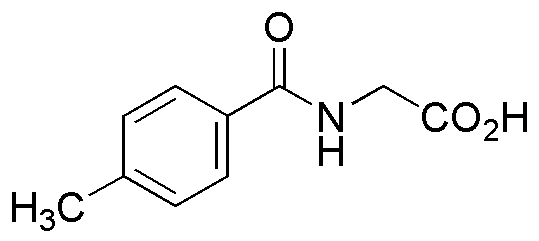4-Methylhippuric acid is widely utilized in research focused on:
- Biomonitoring: This compound serves as a biomarker for exposure to toluene, commonly found in industrial solvents. It helps researchers assess occupational exposure levels in workers.
- Pharmaceutical Development: Its structural properties make it valuable in drug formulation studies, particularly in understanding how compounds interact within the body.
- Environmental Studies: Used in assessing the impact of industrial pollutants, it aids in evaluating the presence of toluene in environmental samples, contributing to ecological health assessments.
- Analytical Chemistry: 4-Methylhippuric acid is employed in chromatographic techniques for the separation and identification of various compounds, enhancing the accuracy of analytical results.
- Metabolic Research: It plays a role in studying metabolic pathways, providing insights into how the body processes aromatic compounds, which is crucial for toxicology and pharmacology research.
General Information
Properties
Safety and Regulations
Applications
4-Methylhippuric acid is widely utilized in research focused on:
- Biomonitoring: This compound serves as a biomarker for exposure to toluene, commonly found in industrial solvents. It helps researchers assess occupational exposure levels in workers.
- Pharmaceutical Development: Its structural properties make it valuable in drug formulation studies, particularly in understanding how compounds interact within the body.
- Environmental Studies: Used in assessing the impact of industrial pollutants, it aids in evaluating the presence of toluene in environmental samples, contributing to ecological health assessments.
- Analytical Chemistry: 4-Methylhippuric acid is employed in chromatographic techniques for the separation and identification of various compounds, enhancing the accuracy of analytical results.
- Metabolic Research: It plays a role in studying metabolic pathways, providing insights into how the body processes aromatic compounds, which is crucial for toxicology and pharmacology research.
Documents
Safety Data Sheets (SDS)
The SDS provides comprehensive safety information on handling, storage, and disposal of the product.
Product Specification (PS)
The PS provides a comprehensive breakdown of the product’s properties, including chemical composition, physical state, purity, and storage requirements. It also details acceptable quality ranges and the product's intended applications.
Certificates of Analysis (COA)
Search for Certificates of Analysis (COA) by entering the products Lot Number. Lot and Batch Numbers can be found on a product’s label following the words ‘Lot’ or ‘Batch’.
*Catalog Number
*Lot Number
Certificates Of Origin (COO)
This COO confirms the country where the product was manufactured, and also details the materials and components used in it and whether it is derived from natural, synthetic, or other specific sources. This certificate may be required for customs, trade, and regulatory compliance.
*Catalog Number
*Lot Number
Safety Data Sheets (SDS)
The SDS provides comprehensive safety information on handling, storage, and disposal of the product.
DownloadProduct Specification (PS)
The PS provides a comprehensive breakdown of the product’s properties, including chemical composition, physical state, purity, and storage requirements. It also details acceptable quality ranges and the product's intended applications.
DownloadCertificates of Analysis (COA)
Search for Certificates of Analysis (COA) by entering the products Lot Number. Lot and Batch Numbers can be found on a product’s label following the words ‘Lot’ or ‘Batch’.
*Catalog Number
*Lot Number
Certificates Of Origin (COO)
This COO confirms the country where the product was manufactured, and also details the materials and components used in it and whether it is derived from natural, synthetic, or other specific sources. This certificate may be required for customs, trade, and regulatory compliance.


